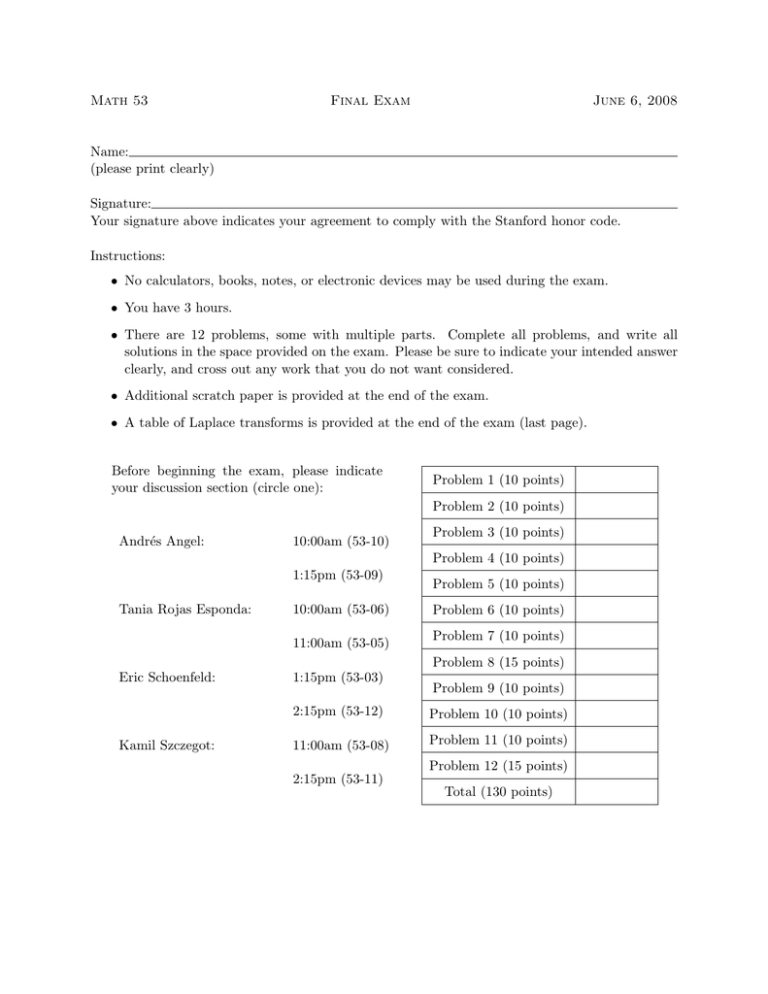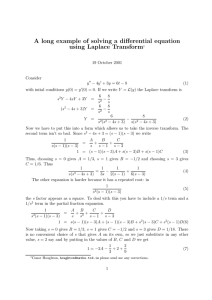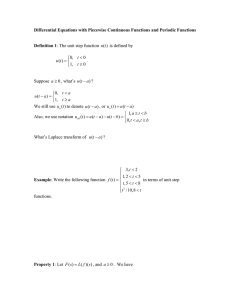Math 53 Final Exam June 6, 2008 Name:
advertisement

Math 53
Final Exam
June 6, 2008
Name:
(please print clearly)
Signature:
Your signature above indicates your agreement to comply with the Stanford honor code.
Instructions:
• No calculators, books, notes, or electronic devices may be used during the exam.
• You have 3 hours.
• There are 12 problems, some with multiple parts. Complete all problems, and write all
solutions in the space provided on the exam. Please be sure to indicate your intended answer
clearly, and cross out any work that you do not want considered.
• Additional scratch paper is provided at the end of the exam.
• A table of Laplace transforms is provided at the end of the exam (last page).
Before beginning the exam, please indicate
your discussion section (circle one):
Problem 1 (10 points)
Problem 2 (10 points)
Andrés Angel:
10:00am (53-10)
Problem 3 (10 points)
Problem 4 (10 points)
1:15pm (53-09)
Tania Rojas Esponda:
10:00am (53-06)
11:00am (53-05)
Eric Schoenfeld:
Kamil Szczegot:
1:15pm (53-03)
Problem 5 (10 points)
Problem 6 (10 points)
Problem 7 (10 points)
Problem 8 (15 points)
Problem 9 (10 points)
2:15pm (53-12)
Problem 10 (10 points)
11:00am (53-08)
Problem 11 (10 points)
2:15pm (53-11)
Problem 12 (15 points)
Total (130 points)
1. Solve the initial value problem
y! =
t2
y+1
y(0) = 1.
2
2. Solve the initial value problem
y ! = (cos t)y + 1
y(0) = 1.
(You may leave your answer in the form of an integral.)
3
3. Describe the behavior as t → +∞ of the solution y(t) to the initial value problem
y! = y2 − y − 6
y(0) = 0.
4
4. Find 2 distinct solutions to the initial value problem
1
y ! = 3t2 (y − 3) 3
y(5) = 3.
Both of the solutions you give should be defined for all real numbers.
5
5. Solve the initial value problem
!
"
! "
1 1
0
!
x =
x+ t
0 1
e
6
! "
1
x(0) =
.
1
6. Solve the initial value problem
1 0 −1
x! = 1 2 0 x
1 0 1
−2
x(0) = 2 .
0
7
7. Consider the system of second order equations
x!! = 2x! − 3y ! + x + 5y
y !! = 4x! + 2y ! − 7x + 4y.
x
x!
If we define x =
y , find a matrix A so that
y!
x! = Ax
(note that you are not being asked to solve the system).
8
8. [15 points]
(a) Compute the Laplace transform L {t cos(at)}.
(b) Compute the Laplace transform L {t sin(at)}.
9
(problem 8 continued.)
(c) Consider the initial value problem
y !! + 100y = cos(10t)
y(0) = 0
y ! (0) = 0.
Find L {y}, and use this to find y. (If you are unable to find y using Laplace transform
methods, you will receive partial credit for using a different method.)
10
(problem 8 continued.)
(d) Consider the initial value problem
y !! + 100y = cos(ωt)
y(0) = 0
y ! (0) = 0.
For which values of ω does the solution stay bounded? (You may use any of the methods
taught in class to solve the equation here.)
11
9. Let
Find the matrix exponential eAt .
!
"
3 −4
A=
.
2 −3
12
10. Consider the linear system
!
"
ε 1
x =
x.
−1 ε
!
Explain the type and stability properties of the critical point at 0 for various values of ε ∈ R.
(If you wish, you can draw a sketch of the phase portrait showing the behavior near 0 for
various values of ε.)
13
11. Assume the system
x! = x(1 − 2x − y)
y ! = y(−1 + x).
models the population of two species. Draw a phase portrait for this system in the first
quadrant (x ≥ 0, y ≥ 0). If x(0) = 1 and y(0) = 1, what will happen to the two populations?
In particular will either species go extinct? (A coordinate plane is provided on the next page.)
14
(Coordinate plane for problem 11. You may choose any convenient scale to use in the graph,
but be sure to indicate this in your picture.)
y
x
15
12. [15 points] Find and classify all critical points, and sketch a phase portrait for the nonlinear
system
x! = y 2 − 4
y ! = x2 − 5 + 2y.
(A coordinate plane is provided on the next page.)
16
(Coordinate plane for problem 12. You may choose any convenient scale to use in the graph,
but be sure to indicate this in your picture.)
y
x
17
(scratch paper)
18
(scratch paper)
19
(scratch paper)
20
(scratch paper)
21
(scratch paper)
22
(scratch paper)
23
Laplace Transform Information Sheet
If f (t) is a function of t, then the Laplace transform of f is the function F (s) defined by the
following formula.
) ∞
F (s) =
e−st f (t) dt.
0
The Laplace transform of f may also be denoted L {f }.
Here are some common Laplace transforms:
L {1} =
L {tn } =
1
s
s>0
n!
s>0
sn+1
1
s−c
a
L {sin(at)} = 2
s + a2
s
L {cos(at)} = 2
s + a2
* +
L ect =
s>c
s>0
s>0
Other Laplace transforms may be found from these basic ones by applying the following general
rules. (For each of the following we assume that f is continuous and of exponential order.)
Rule 1. The Laplace transform of a derivative (assume that f ! is continuous).
* +
L f ! = sL {f } − f (0).
Rule 2. The Laplace transform of tf (t).
L {tf } = −
d
L {f } .
ds
Rule 3. The Laplace transform of ect f (t).
*
+
L ect f (s) = L {f } (s − c).
24







